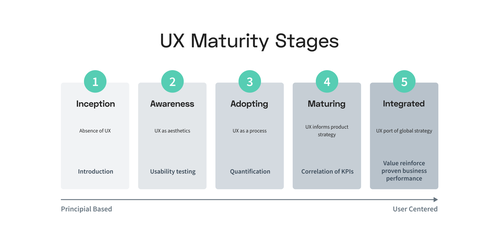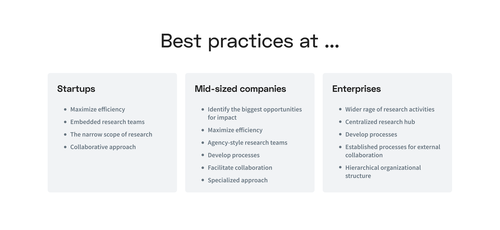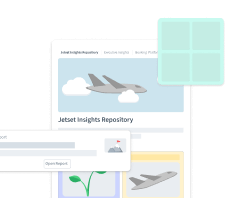
Creating a Research Ops Framework that Works for Your Organization
ResearchOps can bring many benefits to organizations of different sizes: startups, medium-sized companies, and enterprises, and this article will explore the distinctions between different approaches. You will also find the best practices to implement a ResearchOps function and how it can maximize research efficiency and quality and improve collaboration between the companies’ teams.
- What is ResearchOps and why is it important?
- Benefits of ResearchOps
- UX Maturity and Research Ops
- 6 Stages of UX Maturity
- ResearchOps in different types of organizations
- Startup ResearchOps
- Mid-sized ResearchOps
- Enterprise ResearchOps
- How to implement a Research Ops function in 6 steps
- #1. Identify the biggest opportunities for impact
- #2. Assemble a team
- #3. Develop processes
- #4. Create the environment
- #5. Facilitate collaboration
- #6. Constantly re-evaluate
- Final thoughts
What is ResearchOps and why is it important?
ResearchOps (Research Operations) is a relatively new discipline that focuses on improving the effectiveness and efficiency of research teams within organizations. The community, 8000 people strong, is a collective of people (researchers, UX designers, and managers), processes, and tactics that engage in user research.
ResearchOps arose from the need to provide operational support to research teams in organizations. If you are wondering if your organization is ready for a ResearchOps team and how to get started, look up our article on creating a system to scale User Research.
ResearchOps involves a wide range of activities, such as developing processes and tools, managing budgets and resources, and supporting collaboration and communication.
According to The ResearchOps Community website, the models they created are based on 8 pillars: environment, scope, people, organizational context, recruitment and admin, data and knowledge management, governance, and tools and infrastructure.
Benefits of ResearchOps
By adopting a ResearchOps approach, organizations can improve the quality and impact of their research, and better support the work of their researchers.
Improved research quality
By providing researchers with the tools and support they need to be effective, ResearchOps can help organizations produce higher-quality research that is more relevant and valuable to the business.
Increased research efficiency
By streamlining processes and reducing administrative overhead, ResearchOps can help organizations conduct research more efficiently, freeing up time and resources for other activities.
Enhanced collaboration
By facilitating collaboration and communication within the research team, and with other stakeholders, ResearchOps can help organizations tap into the collective knowledge and expertise of their researchers and drive better outcomes.
UX Maturity and Research Ops
How do we know at what stage a company is with their understanding and implementing user research?
One way to understand the role that ResearchOps can play in an organization is to consider the concept of UX maturity. UX maturity refers to the level of understanding and implementation of user research and design thinking within an organization.
6 Stages of UX Maturity
There are generally six stages or levels of UX maturity (according to the Nasdaq model):
Absence of UX Research: At this stage, user research and design thinking are not yet part of the organization's process and may be conducted on an ad hoc basis.
Awareness of UX Research: User research and design thinking are conducted on a project-by-project basis, but there is little consistency in terms of methods, processes, or tools. There is not a lot of awareness in understanding the value of the research.
Adopting UX Research: User research and design thinking are conducted in a repeatable manner, but there is still limited integration into the overall product development process.
Maturing UX Research: User research and design thinking are integrated into the product development process and there are clear processes and guidelines in place.
Integrated UX Research: User research and design thinking are managed as a distinct discipline, with dedicated resources and metrics in place to track progress and impact. User research guides product strategy as well as marketing, branding, and product placement.
Complete UX Research: User research and design thinking are continually optimized and improved based on data and feedback. The entire company is research-centric and the drive to understand users is a driving force.

There are several stages of UX maturity, and each stage may have room for a research ops function to play a role. For example, in the foundational stage, an organization may not yet have a dedicated UX team and may not be doing much user research. In this case, a research ops function may not yet be necessary. However, as the organization begins to prioritize UX and conducts more user research, a research ops function may be able to help streamline and optimize these activities.
If an organization does not currently have a ResearchOps function and is not at a stage where one is necessary, it may be able to work towards introducing one over time. This may involve building the necessary infrastructure, such as establishing a dedicated research team or creating processes and procedures for conducting research. It may also involve building support for the function within the organization, such as by demonstrating the value of user research and the benefits of having a research ops function.
In the intermediate and advanced stages of UX maturity, a research ops function can be even more valuable. At these stages, an organization is likely to have a dedicated UX team and might be conducting user research on a regular basis. A research ops function can help ensure that research activities are aligned with business goals and are conducted efficiently and effectively.
ResearchOps in different types of organizations
ResearchOps can be relevant for a wide range of organizations, from large corporations to startups, and from academic institutions to government agencies. Depending on the type of organization (startup, mid-sized, or enterprise) and the size and setup of the research team (embedded, agency style, or centralized), the role of ResearchOps may vary. For example, in a large corporation, ResearchOps might involve coordinating research efforts across multiple teams and departments. In contrast, in a startup, it might involve setting up processes and tools from scratch.
Startup ResearchOps
Startups are typically smaller organizations with limited resources. As a result, research operations at startups may be focused on maximizing efficiency and making the most of available resources. The most common setup for research teams in startups and small organizations is embedded. Embedded ResearchOps teams are integrated within a product team, providing research support to the product development cycle. That’s why ResearchOps in startups usually involves 1 person, often a researcher or someone else taking on that role, who works closely with the product team to provide insights that inform product decisions.
Startups often have a narrow scope of research activities, focusing on specific areas that are closely aligned with their business goals. This focus allows them to prioritize their research efforts and ensure that they are making the most impact with the least amount of resources.
Startups may have flatter organizational structures, with researchers working closely together and having more flexibility to shape the direction of their research. The embedded setup allows for a close relationship between researchers and other team members, leading to a more collaborative and agile approach. This collaboration helps ensure that research efforts are closely aligned with the needs and goals of the organization.
„A small research team without a dedicated ResearchOps person faces the challenge of not following an established process, having no consistency in the quality of their work, not considering the legal constraints of the practice, and a lack of sharing insights across all the teams. This scene is typical in startup environments, and that’s why the ResearchOps figure is crucial to building the necessary system that helps work responsibly and efficiently and brings impact to the business.“

Mid-sized ResearchOps
Midsized companies may have more resources available for research operations compared to startups, but still fewer resources than enterprises. As a result, research operations at midsized companies may also be focused on maximizing efficiency and making the most of available resources, usually consisting of a single person or a team of 2 or 3, who specialize in different research methodologies.
In mid-sized organizations, we can often see an Agency Style ResearchOps setup, where the research team is separate from the product team, and research services are provided to multiple teams within an organization. This type of ResearchOps setup is common in medium and large organizations that need to conduct research across multiple products or business units. This setup allows for a more specialized approach to research, with the ability to handle a higher volume of research requests.
Enterprise ResearchOps
Enterprises are typically larger organizations with more resources available for research operations, such as budget, staff, and equipment. As a result, research operations at enterprises may be more extensive and may include a wider range of research activities. The ResearchOps personnel form a team depending on the maturity of the company and UX research. This type of centralized research hub, which provides research services to the entire organization, is common in large organizations and enterprises and is called Centralized ResearchOps.
Enterprises have a broader scope of research activities, including more exploratory or speculative research in addition to research that is closely aligned with their business goals. Research operations at enterprises have more established processes for external collaboration, such as partnerships with academia or other industry organizations. These collaborations allow enterprises to leverage the expertise and resources of external partners to support their research efforts.
Enterprises have more hierarchical organizational structures, with research departments organized into distinct functional units. This structure allows for more specialization and efficiency within the research team, but may also result in less flexibility and collaboration compared to flatter structures. Centralized ResearchOps teams are usually composed of a large number of researchers who specialize in different research methodologies. This setup allows for a consistent and standardized approach to research, with the ability to handle a large volume of research requests.
How to implement a Research Ops function in 6 steps
The best practices to implement a ResearchOps function differ from company to company, the size of the team, and the size of the budget. Here are listed some of the ones that have the greatest impact, and down below are listed the specific practices best for companies of different sizes.
#1. Identify the biggest opportunities for impact
The first step in implementing a research operations function is to identify the key challenges and opportunities for improving research in your organization. This is greatly beneficial for startups, as the narrow scope of research that is closely aligned with business goals is suited for limited resources, and medium-sized companies as it maximizes efficiency by focusing on the most important things. By identifying the areas with the greatest potential for impact, you can focus your efforts on the initiatives that will have the greatest return on investment.
#2. Assemble a team
To effectively implement research operations, it is important to assemble a cross-functional team that includes researchers, managers, and other stakeholders. This team should be responsible for overseeing the implementation of research operations and should involve researchers in the planning and decision-making process to ensure that the needs of the research team are taken into account. This is greatly beneficial for mid-sized and big companies where the research team is separate from the product team. Enterprises should prioritize the centralization of their research hubs to coordinate research across departments.
#3. Develop processes
To ensure that research efforts are efficient and effective, it is important to develop clear processes and guidelines for conducting research. This may include defining roles and responsibilities, establishing timelines and budgets, and ensuring compliance with ethical standards. By establishing clear processes, you can ensure that research efforts are well-coordinated and that researchers have the support they need to be successful. This is beneficial for all types of organizations, particularly for mid-sized companies and enterprises that may have more complex research needs and require a more specialized approach.
#4. Create the environment
Providing researchers with access to the tools and resources they need to be effective is an important part of implementing research operations, particularly for startups and mid-sized companies that may have limited resources. This may include specialized software, research databases, and training opportunities. By creating an environment that supports research, you can help researchers be more productive and successful.
#5. Facilitate collaboration
Collaboration and communication are key to the success of research operations. To facilitate collaboration within the research team, and with other stakeholders, it may be helpful to use tools such as project management software and online collaboration platforms. By fostering collaboration, you can help researchers share ideas, knowledge, and resources, and work more effectively together. This is beneficial to companies of all sizes, as in startups it helps researchers be closely aligned with the goals of the organizations, and in enterprises encourages cooperation and collaboration with the academia and different industries, leading to breakthrough discoveries.
Involving users in the design process through methods such as user testing and surveys can help ensure that the final product meets user needs and expectations. Companies like Google are known for their user-centered design approach, which involves extensive user research and testing throughout the design process.
#6. Constantly re-evaluate
Finally, it is important to regularly re-evaluate your research operations to see if they are meeting the needs of the organization and the research team, particularly in startups and mid-sized companies that may need to adapt quickly to changing circumstances and priorities. This may involve benchmarking your progress against industry standards, gathering feedback from researchers and stakeholders, and adjusting your approach as needed to address any challenges or opportunities that arise. By constantly re-evaluating your research operations, you can ensure that they are effective and aligned with the needs and goals of your organization.
To conclude, the best practices in startups, medium-sized companies, and enterprises are as follows:

Final thoughts
ResearchOps can support the work of researchers and drive organizational success by streamlining and optimizing research activities, it can ensure research is conducted in a rigorous and systematic way and help align research with business goals and strategy.
ResearchOps is an important discipline that can help organizations improve the quality and impact of their research efforts.
By adopting a ResearchOps approach, organizations can provide their researchers with the support they need to be effective, and drive better outcomes for the organization as a whole.
Organizations that are looking to get started with ResearchOps can benefit from the tips and actions outlined in this blog post.






